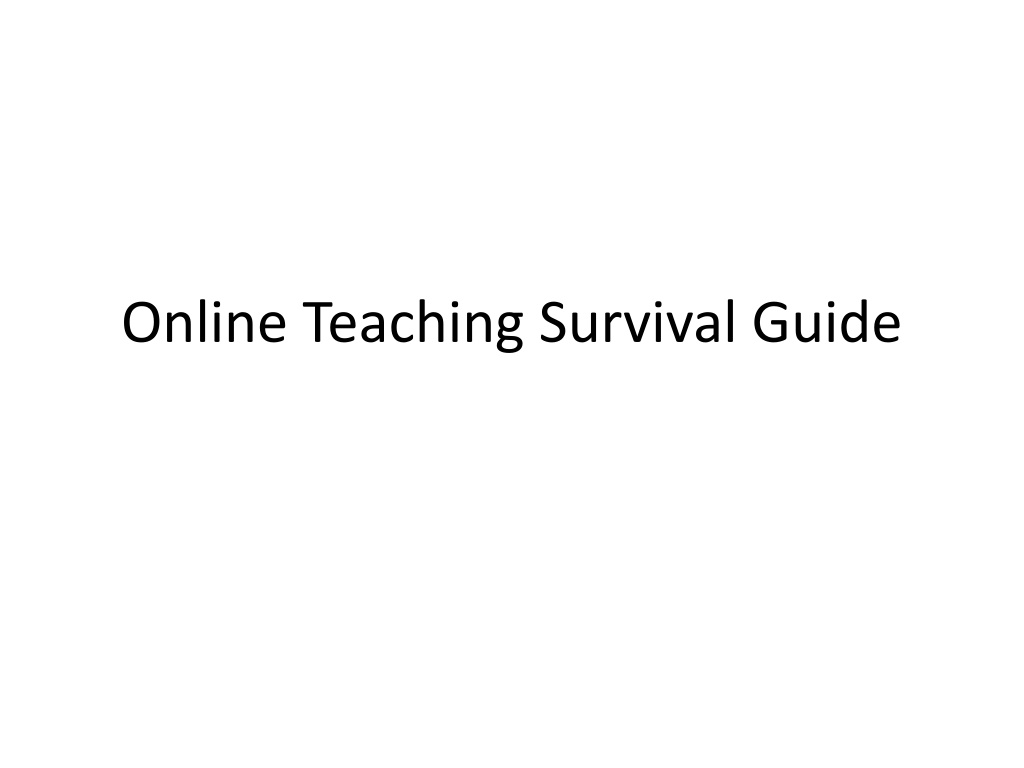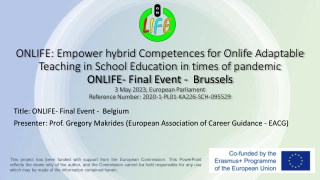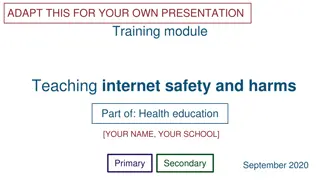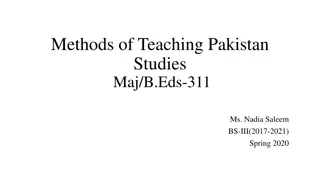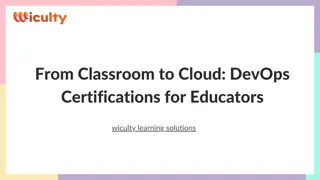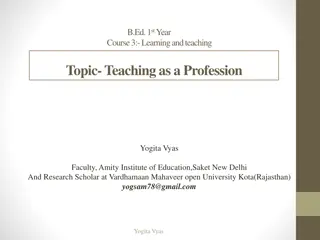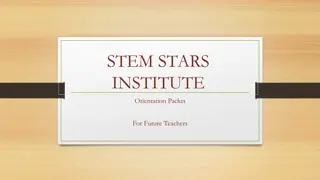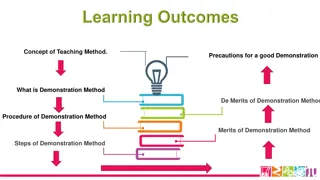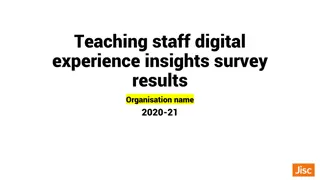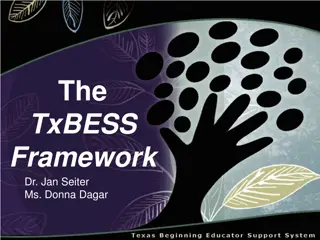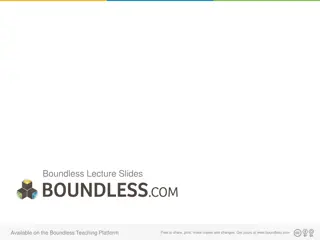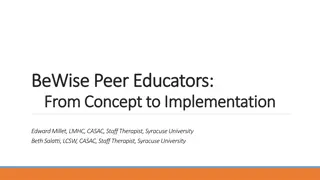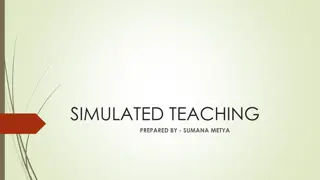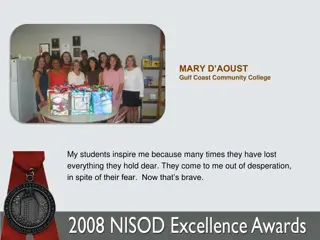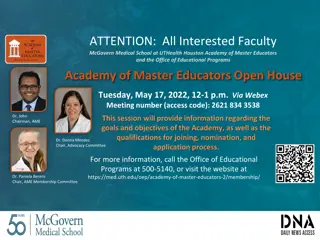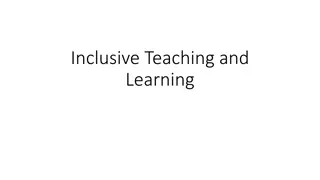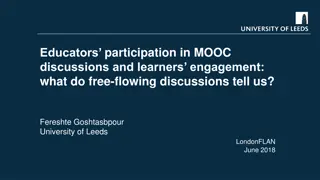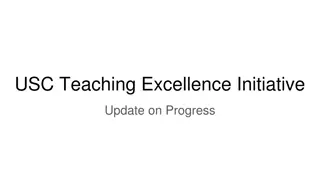Comprehensive Online Teaching Strategies for Educators
Exploring essential elements and practical tips for online course design and facilitation, this guide covers topics such as transitioning from traditional to online teaching, differences between online and face-to-face courses, course phases, syllabus essentials, communication strategies, and engaging students effectively.
Download Presentation

Please find below an Image/Link to download the presentation.
The content on the website is provided AS IS for your information and personal use only. It may not be sold, licensed, or shared on other websites without obtaining consent from the author. Download presentation by click this link. If you encounter any issues during the download, it is possible that the publisher has removed the file from their server.
E N D
Presentation Transcript
Who is teaching online? Low teaching experience Low online training /experience Deans and department chairs have often turned to their faculty and simply assigned them to online courses without much support of training
Difference between online course and f2f course Faculty role shifts to coaching and mentoring. Meetings are asynchronous Learners are more active Learning resources and spaces are more flexible Assessment is continuous
4 phases of a course 1 (CB) - Introduction and group formations 2 (EM) - Whole class or Large group activities 3 (LM) - Small group or specific group activities 4 (CW) - Pruning, reflecting, wrapping up
Phase 1- Introduction and group formations 17 tips for Course Beginning
1- Essential course elements. Syllabus (goals, requirements, textbook, readings, schedule, assessment, contact info) Weekly teaching guide (short memo on weekly assignments) Discussions and rubrics ( spend time to develop good questions and good rubrics for assessment) LMS (You need a CMS, or LMS such as blackboard, Moodle, Sakai, D2L) Checklist Aligning outcomes , activities, and assessment Quality Matters
2- Syllabus Significant Elements Discussion Postings Assignments Communication policies & procedures (Netiquette guidelines) Communication platforms (Wikis, Hangout,,,) Emoticons Plagiarism Expectations (participations, due dates,,,,) Troubleshooting (unexpected situations, whom to contact)
3- Jump start learners What can I do to get my students to actually read my syllabus?
4- Use Bookending Showing the structure of your course so it feels whole, with a beginning, an ending, and set of experiences in the middle, in a motivational and engaging format. Starting with an attention capturing beginning and showing the importance of the ending outcome.
5- Generating energy with specific learning goals How can we move learning outcomes into light and put them to work in learning? An important task for students early in the course is an activity to process and discuss those goals.
6- Maximizing the First Week Contact your students before to the course Make sure technical support staff is available Make sure students have the right tools and know how to access the course.
7- Social and cognitive Presence Social, cognitive, and teaching presence Before the course or at the beginning post something about yourself (getting-acquainted) picture, voice, video Short biography Link to your publications Your favorites Your hobbies Ask students do the same thing
4- Be Present Use the announcement tool frequently Participate in discussions
8- Know your students minds individually Why are you taking this course? What do you expect to learn? What are your goals? What do you know about? Getting acquainted What is particularly unique about you? What is your most memorable aha learning moment?
9- Have a weekly rhythm We learned that if something can be done anywhere, and anytime, it never gets done. Instead, A question or a challenge is posted on Monday Initial responses due by Wednesday Comments on others students posting due by Friday
10- The Why and How of Discussion Boards It is only when students are responding to a question or to another students ideas that they begin to realize what they know and what they don t know.
11- Characteristics of Good Discussion Questions Avoid objective, factual questions Open ended and exploratory Require understanding, applying Questions that ask for more evidence Questions that ask for clarification
12- Meaningful Discussions Hypothetical questions Cause and effect questions Questions on motivation and purpose Reflections and consequences of actions Compare and contrast questions Evaluate something Summary and synthesis questions
13- Response Posts- A 3 part structure What do you think? Why do you believe so? What do you wish you know?
14- Discussion Wraps 1- Summarize the key ideas, what you learned, how did you change, what is next, 2- You may model a summary yourself for the first week and then ask students do it in small groups 3- Create a closing discussion or a wrap-up discussion.
15- Using Discussion Forums to Gather Evidence of Learning 1- Monitoring discussion boards 2- Ensure lively participation 3- Allocate points and use rubrics
16- Feedback in Discussion Posts How Soon, How Much In the early part just let them know you are listening/reading their comments (Scott, thanks for initiating) Encourage the students to be listening to each other. Follow the rubric or grading criteria Later provide expert feedback
17- The Faculty Role As the course progresses, the roles of faculty and students change. Phase 1- Connect 2- Communicate Faculty Provides expectations Forms dyads, creates critical thinking activities Facilitator- Forms small groups of 3-5 and gives collaborative assignments Expert comments- Learners initiate and facilitate the interactions Student Become familiar Dialogue about pros and cons 3- Collaborate Collaborate, solve problems, reflect 4- Co-Facilitate Initiate or participate in interactions/projects
Phase 2- Whole class or Large group activities 16 tips for Early Middle (weeks 1-3)
Tip 1- Announcement, E-mail, and discussion forums Any question worth answering for one student is probably worth answering all of them. Therefore, most often use mass email or announcement rather than personal answers to emails New generation prefers (text) rather than Email. Therefore, text reaches faster than email and email reaches faster than announcements
Tip 2- Monitoring Student Progress Using LMS, CMS tools Use the performance dashboard or similar tools to monitor students access to the LMS/CMS. Use the Item Analysis
Tip 3- Feedback to students If you don t have time for individual feedback due to an increase in course enrollment you may prepare some Feedback Templates Send your feedback both to individuals and to small groups You may use voice or video in your feedback
Tip 4- Early feedback from learners 1. Rubrics, Quizzes, and Peer Review Rubrics: communicate expectations Quizzes: keep them on track Peer Review: Learning is a social experience
Tip 5- Steps in Memory What activities help students remember new and unfamiliar content? Memory and learning take time with repeated exposures and hands-on minds-on activities
Tip 6- Making Your Grading Time Efficient and Formative Don t go overboard with too much feedback Create assignments that mean that you are learning too Be sure to use rubrics and learn how to create reliable and valid rubrics.
Tip 7- Dealing with Difficult Students Contact the student ASAP Describe the students behavior explicitly Listen to student response Discuss appropriate behavior Agree on next steps Summarize and document the meeting or conversation
Tip 8- Building Cognitive Presence Is the extent to which the participants in any particular configuration of a community of inquiry are able to construct meaning through sustained communication.
Tip 9- Core Concepts of a Course Know your core concepts A core concept is a building block for learning outcomes. Example, critical evaluation of online resources
Tip 10- Designing Assessment Plans Participation in group discussion Automated, low-stake quizzes Individual projects Short essays Peer review
Tip 11: Three Best Assessment Practices Assess across Bloom s taxonomy Assess the core concepts Help student succeed on assessment tasks (Explicit expectations, feedback to correct, sample good work)
Phase 3: Letting Go of Power in the Late Middle 16 tips for the late middle phase
Tip 1: Questions and Answers Instead of you asking questions let students post their questions Teach students how to ask good questions Practice stump the faculty - students asking faculty some challenging questions
Tip 2: Making Your Students Knowledge Visible 1. Prepare students to develop questions for experts. 2. Ask your students to link (Connect) the new ideas to their exiting knowledge. 3. Ask Meta-cognition questions- their Aha moments , how your ideas have changed.
Tip 3: Developing Rigor in Our Questioning: Ask questions that require clarity, precision, accuracy, relevance, depth, breadth, logic, fairness.
Tip 4: Moving Beyond Knowledge Integration Getting students to define the problem and decide on resolution strategies Develop problem solvers and critical thinkers
Tip 5: Simple Rules for Feedback Provide feedback early and often Read/watch students introductions and acknowledge them Tell them when they should expect feedback Rapid response to questions Provide personal and formative feedback
Tip 14: Using Social Networking Techniques Social networking tools empower learners to comment on and develop their own work on the work of peers and experts.
Tip 15- Experts: A Touch of Spice Invited experts can add a bit of spice to your course for you and your students. Adds another perspective for core concepts It also helps with community-building of the course.
Phase 4: Pruning, Reflecting, and Wrapping Up Use What if Scenarios Stimulate and Comfortable teamwork Train Learners to become Leaders Concept Mapping
Phase 4: Pruning, Reflecting, and Wrapping Up Pausing, Reflecting, and Pruning Strategies Wrapping Up a Course with Style Real Time Closing Gatherings Debriefing Techniques: What One Change Would Students Recommend?
